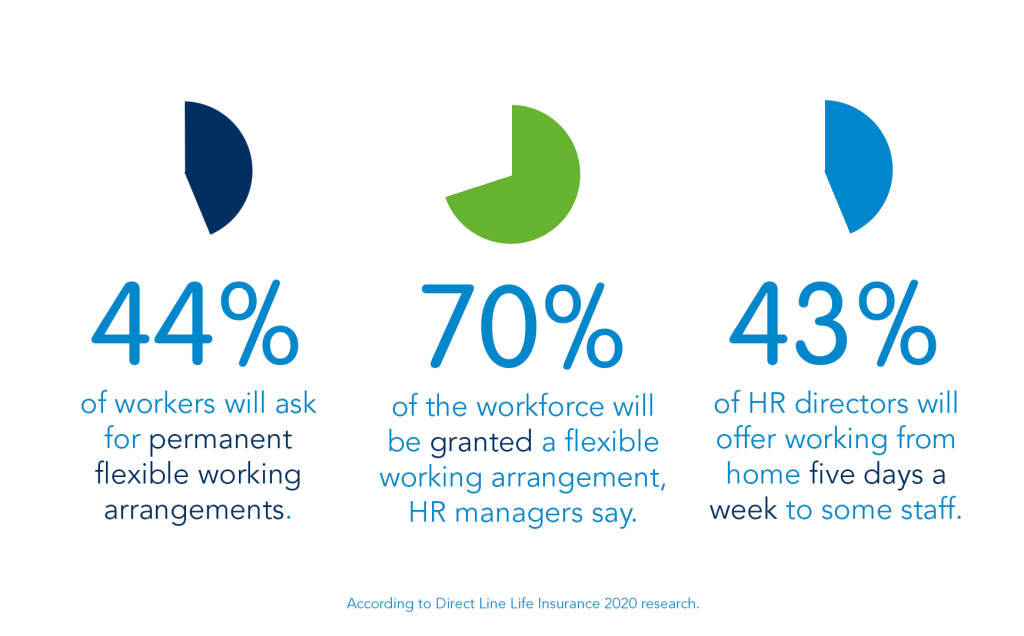13 Million Brits To Request Permanent Flexible Working: How to Prepare

How has lockdown changed people’s attitudes to flexible and home working?
Over 13 million people across the UK plan to ask to modify their long-term working pattern, according to new research by Direct Life Line. HR managers will have to be prepared for the influx of new requests once the current COVID-19 restrictions have been lifted.
What Do Employees Want?
With half (49%) of the workforce experiencing the benefits of working from home first-hand,2 it’s no wonder that 44% of employees are hoping that flexible working will be part of their new routine once they return to the workplace.1
For those wanting to maintain long-term flexible arrangements, working from home two days a week is the favourite option with 12% of people wishing to do so. The second most favoured options were working from home one or three days a week (10% each). This routine would provide people with the opportunity to take a rest from commuting on their home days, whilst enjoying a social and collaborative working environment when in the office.
However, the current lockdown has also shown both employers and staff that working completely from home is not only feasible, but is sometimes preferable. It is not surprising therefore that 8% of people are planning to ask their employer to work from home every day of the week.
Key statistics

- 44% of workers (over 13 million people) plan to ask for permanent flexible working arrangements after coronavirus restrictions are fully lifted.
- Key drivers for this are saving time and money, alongside prioritising family and health.
- HR directors expect 70% of the workforce will have some form of a flexible arrangement after coronavirus restrictions are fully lifted. This is a 45% increase on current levels.
- Most popular new working patters are working from home 2 days a week (12% of people), 3 days a week (10%), 1 day a week (10%), and permanently.
- 43% of HR directors say they will offer some employers the option of working from home five days a week, and 20% say they will offer three or four days a week.
Reasons for Wanting Flexible Working
During the lockdown, employees have been getting accustomed to working from home and this study suggests they want to retain the benefits moving forwards. Key reasons that people want to work from home include saving money (31%) and time (23%) on commuting, plus spending more time with loved ones including their children (22%), partners (18%) and broader family (15%).
Prior to the pandemic, employees had the right to request a flexible working pattern, but many didn’t consider that their employer would accept the request. However, the pandemic has meant that many people have reassessed their priorities in life including their working habits. This, and increased confidence in working effectively at home, has changed people’s mindset.
How Are Other HR Managers Preparing?
Establishing a more flexible working arrangement does not come as a surprise, as the ongoing changes to working life has been on managers’ minds – and the news – for six months now. As such, HR managers are preparing for the influx of requests once the workplace becomes safe enough to return to.
HR directors predict there will be a 45% increase in the number of their employees requesting some form of flexible working compared to before the pandemic.3 If this is correct, this could mean 70% of the workforce that are able to will work flexibly long-term after coronavirus restrictions are lifted.
Over two fifths (43%) of HR directors say they will offer some employees the option to work from home five days a week, while one in five (20%) will offer employees the chance to work from home three or four days a week.
How You Can Manage the Requests
So how are you going to prepare for this influx of requests in your business? Here is the advice from our HR experts on how to manage this process.
The Process of Dealing with Flexible Working Requests
- Ensure you have a flexible working policy in place and this is available for an employee to review. This can help an employee understand the process.
- Ensure the request is acknowledged and dealt with in a reasonable timeframe. From receiving the request all the way through to concluding any appeal must not take any longer than three months.
- Always make sure any meeting is held is given the time and attention it requires. The process cannot be rushed or the employee will be feeling disengaged or confused about the process.
- There are 3 likely outcomes from a flexible working request; to accept the request, to trial the request or to reject the request.
- If rejecting a request, an employer must ensure they can evidence and demonstrate which of the legal reasons it applies to. This is important for both employee and company to understand.
- It can be an emotive subject, therefore always make sure you listen to your employee’s reasoning for the request before making a decision.
- If the request cannot be dealt with within 3 months, ensure you communicate with the employee and gain their agreement to postpone the request.
Considerations Prior to Accepting the Request
Consider the request carefully: balancing the individuals’ personal circumstances and the practicalities of remote working. You will also want to consider:
- Will the request incur additional costs that will damage your businesses
- Are you able to reorganise work among existing staff
- Are you able to recruit additional staff
- Will you see an impact (if any) on service quality, individual performance or meeting customer demand
- Is there sufficient work for the employee to carry out over the requested period of time
- Are you planning on making changes to the workforce otherwise
Trialling Flexible Working
- The trial period start and end dates (we would recommend any trial period should be less than 3 months).
- That the trial arrangements will be subject to ongoing and regular review.
- Agreeing in advance the measures for the success of the trial period and/or that either party can ask to extend the trial. This includes any proposed extension to the trial needing to be agreed in writing.
The Future of Flexible Working
In good news for employees, the pandemic and how it has impacted working life is making employers reconsider their approach to flexible working requests. With the combination of the costs of running an office as well as the benefits employees are citing, it is not surprising that these requests are to be accommodated more in the future.
The pandemic also impacted employees’ attitudes, leading them to question their approach to work and what they find to be positive about working at home versus in the office. We’re sure to see some big changes to the UK job market within the next year as these changes are put into effect.
Bookmark our Knowledge Centre or sign up to our Newsletter (see the footer below) to stay up-to-date with COVID-19 news and changes to legislation.
Resources
1 Opinium and Direct Life Line 2020.
2 The Office for National Statistics Coronavirus and the social impacts on Great Britain.
3 Pure Profile research on 100 HR Directors in the UK.



